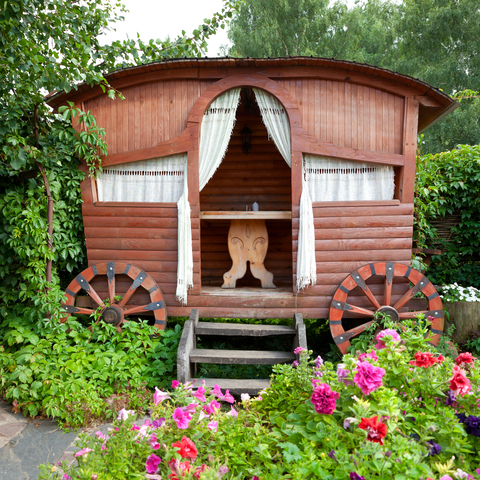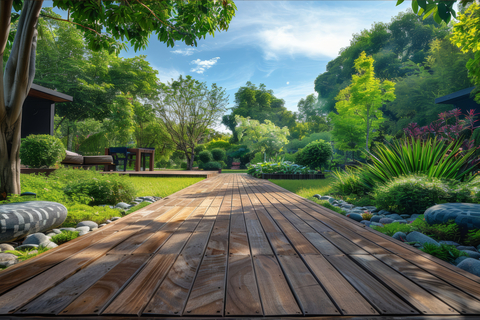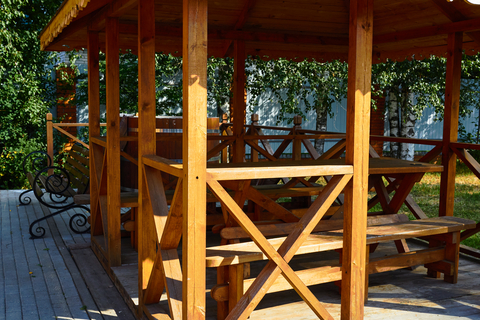Building timber structures in your garden can add charm, functionality, and value to your outdoor space. Whether you’re planning a cosy gazebo, a sturdy shed, or an elegant pergola, timber offers versatility and natural beauty. However, it’s crucial to prioritise safety when undertaking such projects.
Planning and Design
Initial Planning and Site Assessment
Step 1: Site Survey and Documentation
- Measure and map out your garden area
- Note existing features (trees, structures, utilities)
- Take photographs for reference
- Check property boundaries to ensure compliance
Step 2: Soil Analysis
- Assess soil type (clay, sand, loam, etc.)
- Test soil drainage by digging a hole and filling it with water
- Check for soil stability and potential erosion issues
- Consider professional soil testing if in doubt
Step 3: Topography and Drainage Evaluation
- Identify any slopes or uneven areas
- Determine natural water flow patterns
- Plan for proper drainage away from the structure
- Consider the need for land levelling or terracing
Step 4: Utilities and Obstacles Assessment
- Locate underground utilities (call local services for guidance)
- Identify overhead power lines or other obstructions
- Plan for safe distances from existing structures
- Consider access for construction and future maintenance
Step 5: Legal and Environmental Considerations
- Check local building codes and zoning regulations
- Determine if planning permission is required
- Assess potential environmental impacts
- Consider sun exposure and wind patterns for optimal placement

Choosing the Right Timber
Selecting appropriate timber is fundamental to the safety and durability of your structure.
| Timber Type | Best For | Characteristics | Safety Considerations |
| Pressure-Treated Pine | – Decking. – Fence posts. – General framing | – Affordable. – Resistant to decay and insects | – Ensure proper ventilation. – Use appropriate fasteners to prevent corrosion |
| Cedar | – Pergolas. – Arbores. – Decorative elements | – Naturally resistant to decay. – Aromatic. – Attractive appearance | – Check for splinters. – May require periodic sealing for longevity |
| Redwood | – High-end decking. – Outdoor furniture. – Exposed beams | – Naturally resistant to decay and insects. – Stable and less prone to warping | – Higher cost may impact project budget. – Ensure sustainable sourcing |
| Oak | – Heavy-duty structures. – Load-bearing elements | – Extremely durable. – High strength-to-weight ratio | – Prone to splitting; pre-drill holes. – May require specialised tools due to hardness |
| Larch | – Cladding. – Decking. – Outdoor structures | – Naturally durable. – Attractive grain | – Can be slippery when wet; consider anti-slip treatments for decking |
| Treated Softwoods | – General construction. – Framing. – Utility structures | – Cost-effective. – Widely available | – Ensure treatment is suitable for ground contact if necessary. – Use appropriate protective gear when cutting |
What all to keep in mind?
Structural Integrity
-
Ensuring Stability and Strength
One of the most critical safety considerations for building timber structures is ensuring structural integrity. Design your structure with stability in mind, considering factors like wind load and weight distribution. Use appropriate joinery techniques and reinforce critical points with metal brackets or connectors. The right fasteners and connectors play a vital role in the overall strength of your structure, so choose corrosion-resistant options suitable for outdoor use.
-
Load-Bearing Considerations
Understanding load-bearing requirements is essential, especially for structures like decks or elevated platforms. Calculate the expected load, including the weight of the structure itself, furniture, and occupants. Ensure your foundation and support beams are adequately sized to handle the load. When in doubt, consult a structural engineer to verify your design meets safety standards.
-
Safety During Construction
Personal Protective Equipment (PPE): Safety should be your top priority during the construction phase. Always wear appropriate Personal Protective Equipment (PPE) when working on your timber structure. This includes safety glasses to protect your eyes from sawdust and debris, sturdy gloves to prevent splinters and cuts, and steel-toed boots to safeguard your feet from falling objects. A hard hat is also recommended, especially when working on taller structures.
Safe Use of Tools and Equipment: Familiarise yourself with the proper use of both hand and power tools. Keep all tools in good condition and use them as intended. When using power tools, ensure they’re properly grounded and use circuit breakers to prevent electrical hazards. Always follow the manufacturer’s safety guidelines and wear appropriate PPE when operating machinery.
-
Weather Considerations
Working in Different Weather Conditions: UK weather can be unpredictable, so it’s important to consider safety in various conditions. Avoid working in heavy rain or strong winds, as wet timber can be slippery and wind can make it difficult to control materials. If you must work in damp conditions, use non-slip footwear and ensure your work area is as dry as possible. Protect your timber from excessive moisture during construction to prevent warping or swelling.
-
Fire Safety
Fire-Resistant Treatments: Fire safety is a crucial aspect of timber construction safety tips. Consider applying fire-resistant treatments to your timber, especially for structures close to your home. These treatments can significantly slow the spread of fire, providing valuable time in an emergency. There are various fire-retardant coatings and impregnation treatments available; consult with your timber supplier to find the most suitable option for your project.
Fire Safety Regulations in the UK
The key UK fire safety regulations relevant to timber structures in gardens are:
Building Regulations Part B: Fire Safety
- Part B of the Building Regulations in England and Wales covers fire safety requirements for all buildings, including non-habitable structures like garden buildings.
- The regulations aim to ensure adequate fire escape routes, prevent fire spread, and provide access for firefighters.
- While the strictest requirements apply to habitable buildings, the regulations still have implications for timber structures in gardens.
BS EN 13501-5 for Roofs and Roof Coverings
- This European standard provides fire performance classifications for roofs, including those on garden structures.
- Roofs must meet at least a ‘BROOF(t4)’ classification, which requires non-combustible or fire-retardant materials.
Timber Treatment and Fire Resistance
- Untreated timber is often rated as having a ‘medium’ contribution to fire, but can be upgraded to ‘minor’ or ‘limited’ contribution through fire-retardant treatments.
- Applying fire-retardant coatings or pressure-treating the timber can significantly improve its fire resistance for use in garden structures.
While garden structures face less stringent requirements than habitable buildings, it is still important to:
- Use fire-resistant or fire-treated timber to reduce the flammability of the structure.
- Ensure the roof and any other combustible elements meet the minimum ‘BROOF(t4)’ fire performance classification.
- Adhere to the general principles of Building Regulations Part B to prevent fire spread and provide adequate access for firefighters.
UK Regulations and Compliance
Building Regulations and Planning Permission
When building garden structures, it’s essential to comply with UK regulations. Most garden structures fall under ‘permitted development‘ and don’t require planning permission, but there are exceptions. Structures exceeding certain heights or located close to property boundaries may require approval. Check with your local planning authority to ensure your project complies with current regulations.
Environmental Considerations
Consider the environmental impact of your timber structure. UK regulations increasingly focus on sustainability in construction. Choose timber from certified sustainable sources and consider the lifecycle of your structure. Linnell Bros offers a range of responsibly sourced timber products that meet both safety and environmental standards.
Maintenance and Long-Term Safety
-
Regular Inspection and Maintenance
To ensure the long-term safety of your timber structure, regular maintenance is crucial. Inspect your structure periodically for signs of wear, damage, or decay. Pay special attention to load-bearing elements, joints, and areas exposed to moisture. Address any issues promptly to prevent small problems from becoming safety hazards.
-
Protecting Against Pests and Rot
Protect your timber structure from pests and rot to maintain its integrity. Use appropriate treatments and finishes to guard against insects and fungal decay. Ensure good ventilation in your structure to prevent moisture buildup, and consider using a water-repellent sealant to protect against rain and damp.
Building a timber structure in your garden can be a rewarding project, but safety should always be your top priority. By following these garden construction best practices and adhering to timber building regulations UK, you can create a beautiful, durable, and safe addition to your outdoor space. Remember to plan carefully, use high-quality materials, prioritise structural integrity, and maintain your structure regularly.

Choose Linnell Bros today!
Ready to bring your garden vision to life safely and beautifully? Look no further than Linnell Bros for all your timber needs. With our extensive collection of high-quality, sustainably sourced timber and expert knowledge on safety considerations for building timber structures, we’re your ideal partner for any garden project. From treated softwoods to premium hardwoods, we have the perfect materials and services for your decking, pergola, or shed. Our team is ready to offer personalised advice on selecting the right timber and building garden structures safely. Don’t compromise on quality or safety – contact Linnell Bros today.


